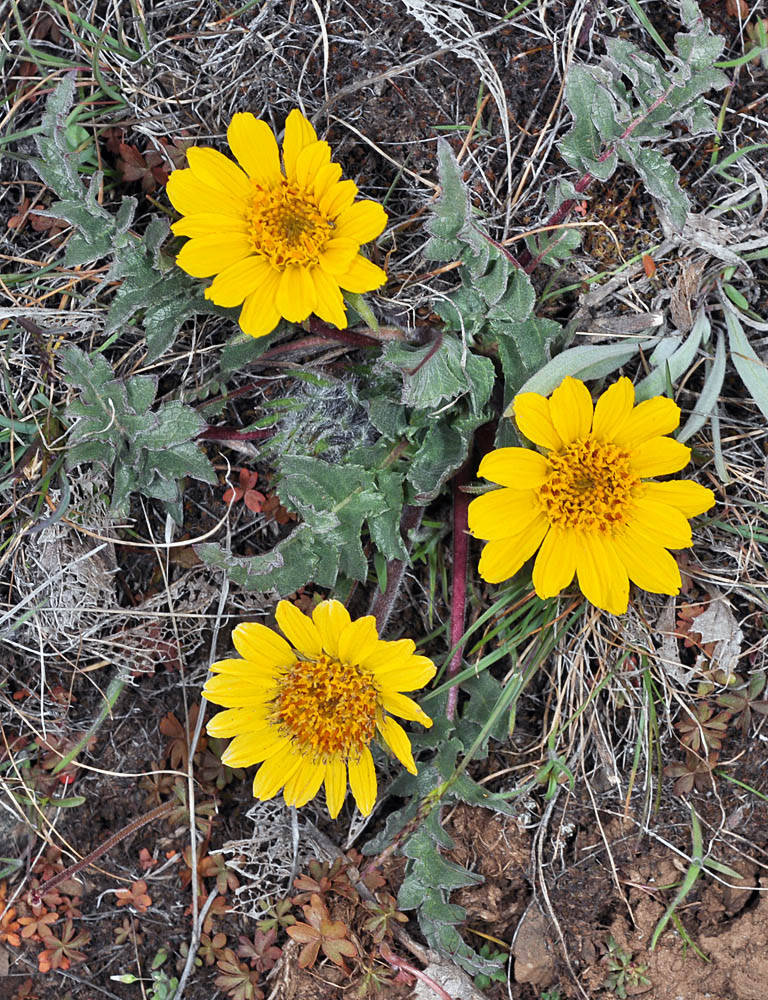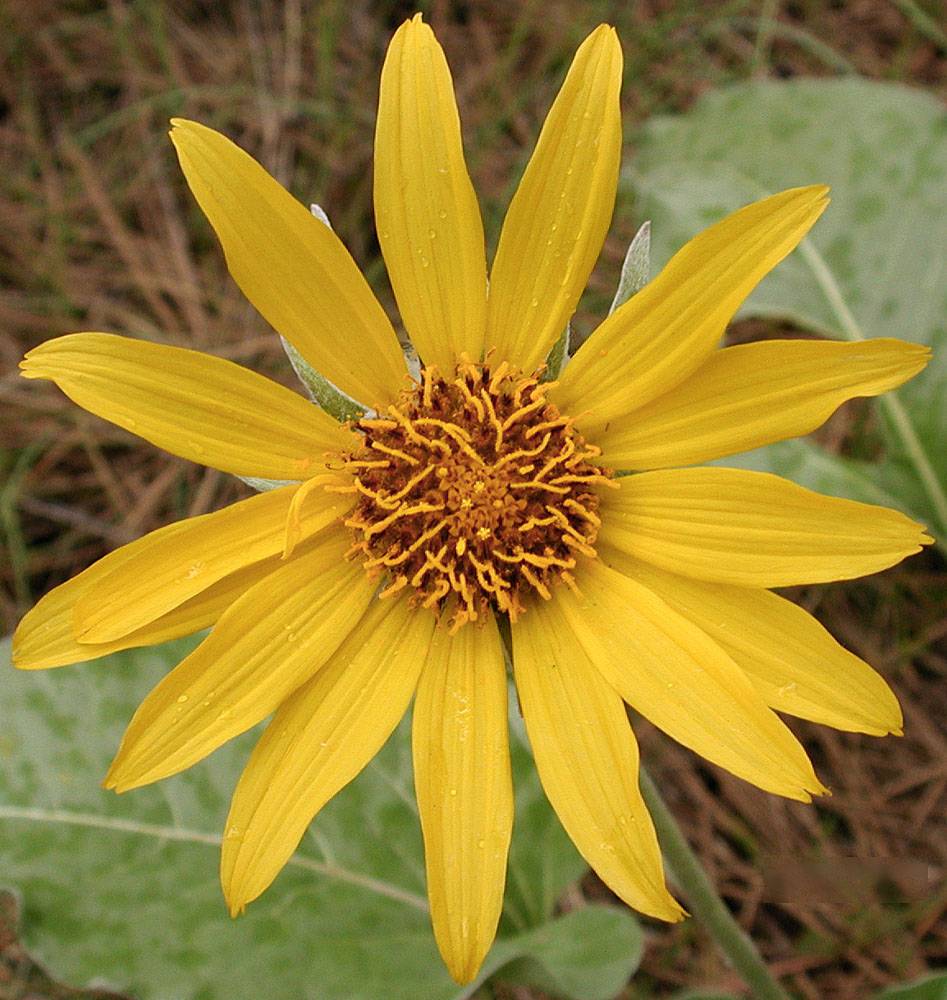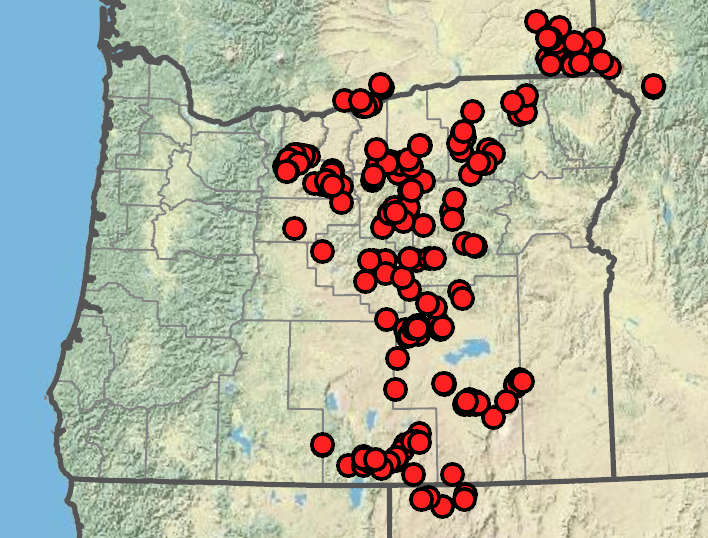Balsamorhiza serrata
Balsamorhiza sagittata
serrate balsamroot
arrowleaf balsamroot
5–34 cm, sparsely villous-tomentose; from single taproot.
forming clumps, 20–65 cm, gray-tomentose.
ovate-lanceolate, undivided to pinnatifid, rarely with some leaves pinnately compound;
margins sharply serrate;
tips apiculate;
surfaces sparsely hispid;
basal leaves in 1–few rosettes;
blades 4.5–15 × 2–5.5 cm;
pinnae (when present) 4–11 mm wide;
petioles 1–9(13) cm, often one or more bract-like basal leaves present;
cauline leaves of 1 pair (when present); opposite;
blades 1–4(5.5) × 0.6–1.5 cm;
petioles 2–5.5(6.5) cm.
simple; ovate, bases cordate or sagittate;
margins entire;
surfaces tomentose; more densely so abaxially than adaxially;
basal leaves in multiple rosettes;
blades 7–27 × 4.5–14.5 cm;
petioles 8–39 cm;
cauline blades 3–5.5 × 0.5–0.9 cm;
petioles 0.7–5.5 cm.
with 1 terminal head.
with 1 larger; terminal head; and rarely 1–3 smaller; axillary peduncles 0.2–13 cm.
13–15 × 10–30 mm.
terminal 10–15 × (10)15–30 mm; axillary 8 × 8–12 mm.
8–21, yellow;
rays 13–24 × 4–9 mm.
8–19 on large heads, 5–9 on small heads, yellow;
rays 25–40 × 7–18 mm.
~8 mm.
6–8 mm.
linear-lanceolate, 11–18 × 2–4 mm;
tips acuminate, sparsely to densely villous-tomentose.
lanceolate, 10–32 × 3–7 mm; outer often longer, densely tomentose, especially basally.
6–7 × 1.5–2 mm, glabrous.
6–7 × 1.2–2 mm, glabrous.
11–12 mm.
9–11 mm.
=38.
Balsamorhiza serrata
Balsamorhiza sagittata
Dry open areas, serpentine. Flowering Apr–Jun. 600–2100 m. BR, BW, Col, ECas, Lava. CA, NV, WA. Native.
Balsamorhiza serrata is distinct among members of the genus Balsamorhiza in generally having simple leaves with serrate margins and tapered (not sagittate) bases. Some plants have pinnately divided leaves. Further work may show that these plants are actually hybrids between B. serrata and B. hookeri or B. hispidula. Balsamorhiza serrata is known to hybridize with B. sagittata.
Open areas, edges of forests, open woodlands. Flowering Apr–Jul. 300–2100 m. BR, BW, Col, ECas, Owy. CA, ID, NV, WA; north to British Columbia, northeast to Alberta, east to SD, southeast to AZ. Native.
This is the most widespread species of Balsamorhiza. It hybridizes with every species of section Balsamorhiza with which its range overlaps but is itself morphologically quite uniform and easy to distinguish from the other members of section Artorhiza. Its hybrids with B. incana have been given the name B. × tomentosa.
Abigail (Abby) Moore
Abigail (Abby) Moore
- Local floras:
BC,
CA,
OR,
WA
- Local Web sites:
CalFlora,
CalPhotos,
Flora NW,
PNW Herbaria,
Turner Photog.
WildflowerSearch
iNaturalist (observations)
USDA Plants Database
- LBJ Wildflower Center
- SEINet
- Plants of the World Online
- Encyclopedia of Life
- Wikipedia
- Google Image Search





